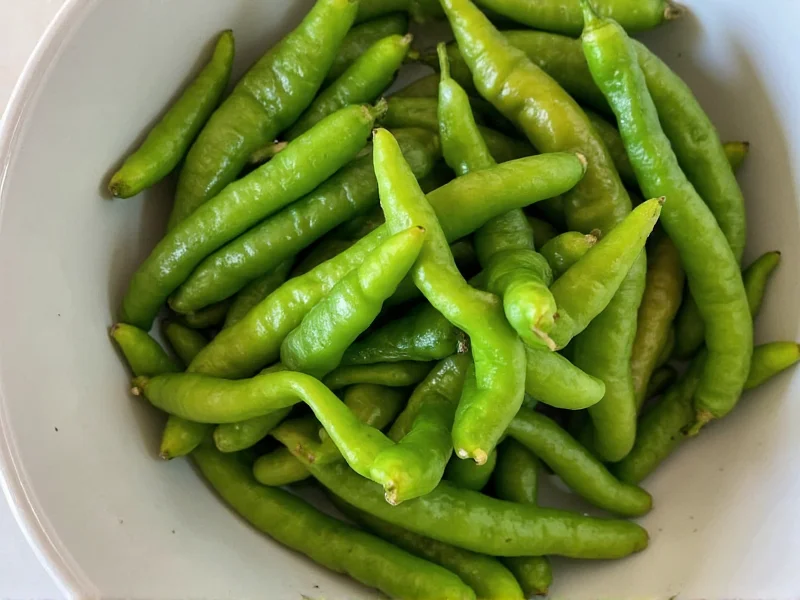Drying serrano peppers transforms your garden harvest into a versatile kitchen staple that maintains its signature 10,000-25,000 Scoville heat units while concentrating flavor. This preservation technique works because removing moisture inhibits microbial growth that causes spoilage. Whether you've grown your own serranos or bought them in bulk, drying extends their shelf life dramatically while creating ingredients perfect for salsas, stews, and spice blends.
Why Dry Serrano Peppers?
Serrano peppers, native to Mexico's mountainous regions, offer a bright, grassy heat that intensifies when dried. Unlike jalapeños, serranos maintain remarkable flavor complexity through the drying process. Home drying preserves peak freshness better than store-bought dried chilies, which often lose volatile compounds during extended shipping and storage. You'll save money compared to purchasing dried serranos commercially while gaining control over the final product's texture and heat level.
Preparation: Selecting and Prepping Peppers
Choose firm, unblemished serrano peppers at their peak ripeness—typically deep green but turning red as they mature. Red serranos contain more capsaicinoids, yielding slightly hotter dried peppers. Wash thoroughly and pat completely dry with clean towels. For optimal results when learning how to dry fresh serrano peppers properly, wear gloves to prevent capsaicin burns.
Most experts recommend removing stems but keeping peppers whole to preserve essential oils. If using a dehydrator, slice peppers lengthwise for faster drying while maintaining shape. Never remove seeds before drying—they contain valuable flavor compounds that would otherwise evaporate. The ideal moisture content before drying is 85-90%, which fresh serranos naturally possess.
Drying Methods Compared
| Method | Temperature | Time Required | Energy Cost | Best For |
|---|---|---|---|---|
| Food Dehydrator | 125°F (52°C) | 8-12 hours | $$ | Consistent results, large batches |
| Oven Drying | 175°F (80°C) | 6-10 hours | $$$ | Quick processing, small batches |
| Air Drying | Ambient | 3-4 weeks | $ | Traditional method, low humidity climates |
Step-by-Step Drying Instructions
Using a Food Dehydrator (Recommended Method)
This method delivers the most consistent results when drying serrano peppers for long-term storage. Arrange prepared peppers in a single layer on dehydrator trays with space between each pepper. Set temperature to 125°F (52°C)—higher temperatures risk cooking rather than drying. Check periodically after 6 hours; peppers are done when brittle and snapping cleanly when bent. Total drying time typically ranges from 8-12 hours depending on pepper thickness and ambient humidity.
Oven Drying Technique
For those wondering how to dry serrano peppers in the oven without special equipment, preheat to lowest setting (175°F/80°C). Place peppers on wire racks over baking sheets to allow air circulation. Prop oven door open 2-3 inches using a wooden spoon to maintain airflow. Rotate trays hourly for even drying. Check every 2 hours after the 4-hour mark. This method requires more attention but works well for small batches when time is limited.
Traditional Air Drying Method
The most energy-efficient approach for air drying serrano peppers naturally at home involves threading peppers onto cotton string through the stem ends (wear gloves!). Hang in a warm, dark, well-ventilated area with 50-60% humidity. Ideal locations include attics or shaded porches. Complete drying takes 3-4 weeks. Check weekly for mold, especially in humid climates. This method preserves complex flavor compounds better than heat-based methods but requires suitable environmental conditions.
Testing for Complete Dryness
Properly dried serrano peppers should exhibit these characteristics:
- Leathery to brittle texture depending on method
- No visible moisture when broken open
- Snap cleanly when bent (not just crease)
- Weight reduced by 80-85% from fresh state
Under-dried peppers risk mold during storage, while over-dried peppers become excessively brittle and lose flavor. The ideal dried serrano maintains slight flexibility while snapping cleanly—a balance achieved through careful monitoring during the final drying hours.
Proper Storage Techniques
Once completely dry, store serrano peppers in airtight containers away from light and moisture. For maximizing shelf life of dried serrano peppers, follow these steps:
- Cool peppers completely at room temperature (1-2 hours)
- Store in glass jars with oxygen absorbers or vacuum-sealed bags
- Keep in dark pantry or cupboard (not refrigerator)
- Check monthly for moisture or mold
Well-stored dried serranos maintain peak quality for 6-12 months. For extended storage up to 2 years, freeze in airtight containers. Never store dried peppers near heat sources or in humid environments, as this accelerates flavor degradation.
Culinary Uses for Dried Serrano Peppers
Dried serranos offer unique applications beyond fresh peppers. Rehydrate in hot water for 20 minutes before using in salsas or sauces for concentrated heat. Crumble directly into spice rubs—their thinner walls compared to jalapeños make them easier to pulverize. Create custom hot sauces by blending rehydrated serranos with vinegar and spices. For using dried serrano peppers in traditional Mexican cooking, add whole peppers to simmering beans or stews, removing before serving.
Troubleshooting Common Issues
Peppers developing mold: Usually indicates insufficient airflow or high humidity. Increase ventilation or add silica gel packets to storage containers.
Peppers becoming leathery but not brittle: Continue drying process—this indicates surface moisture has evaporated but internal moisture remains.
Flavor loss during drying: Avoid temperatures above 135°F (57°C) which degrade volatile flavor compounds. Use lower temperatures for longer periods.











 浙公网安备
33010002000092号
浙公网安备
33010002000092号 浙B2-20120091-4
浙B2-20120091-4